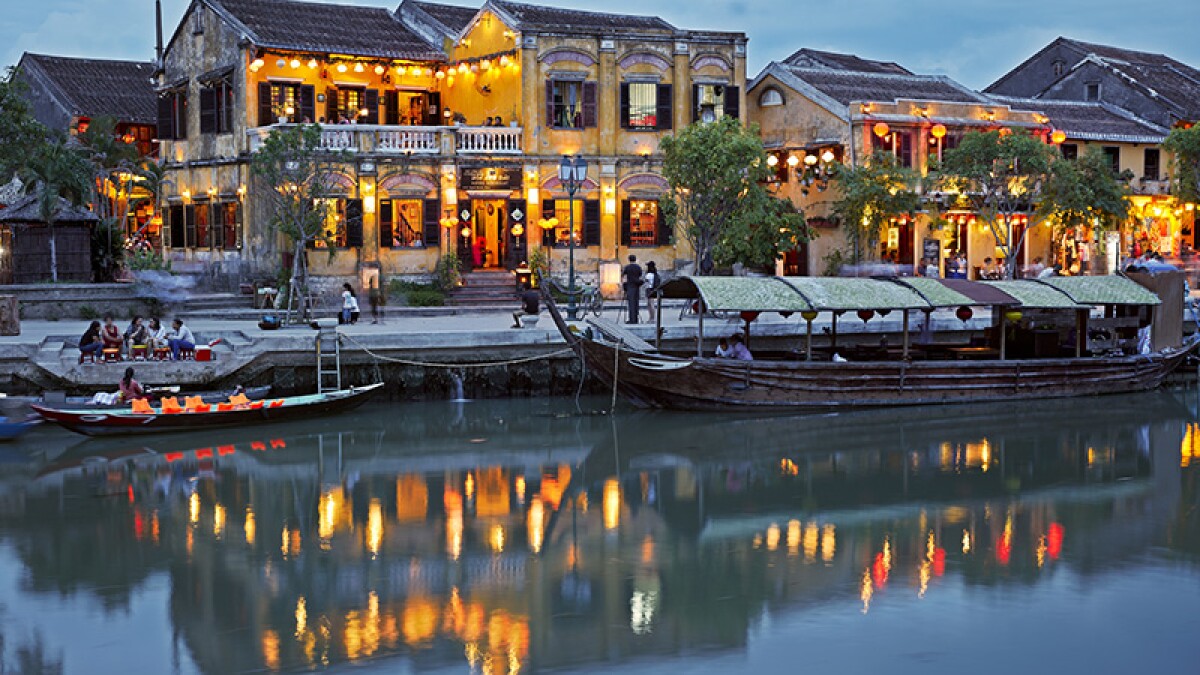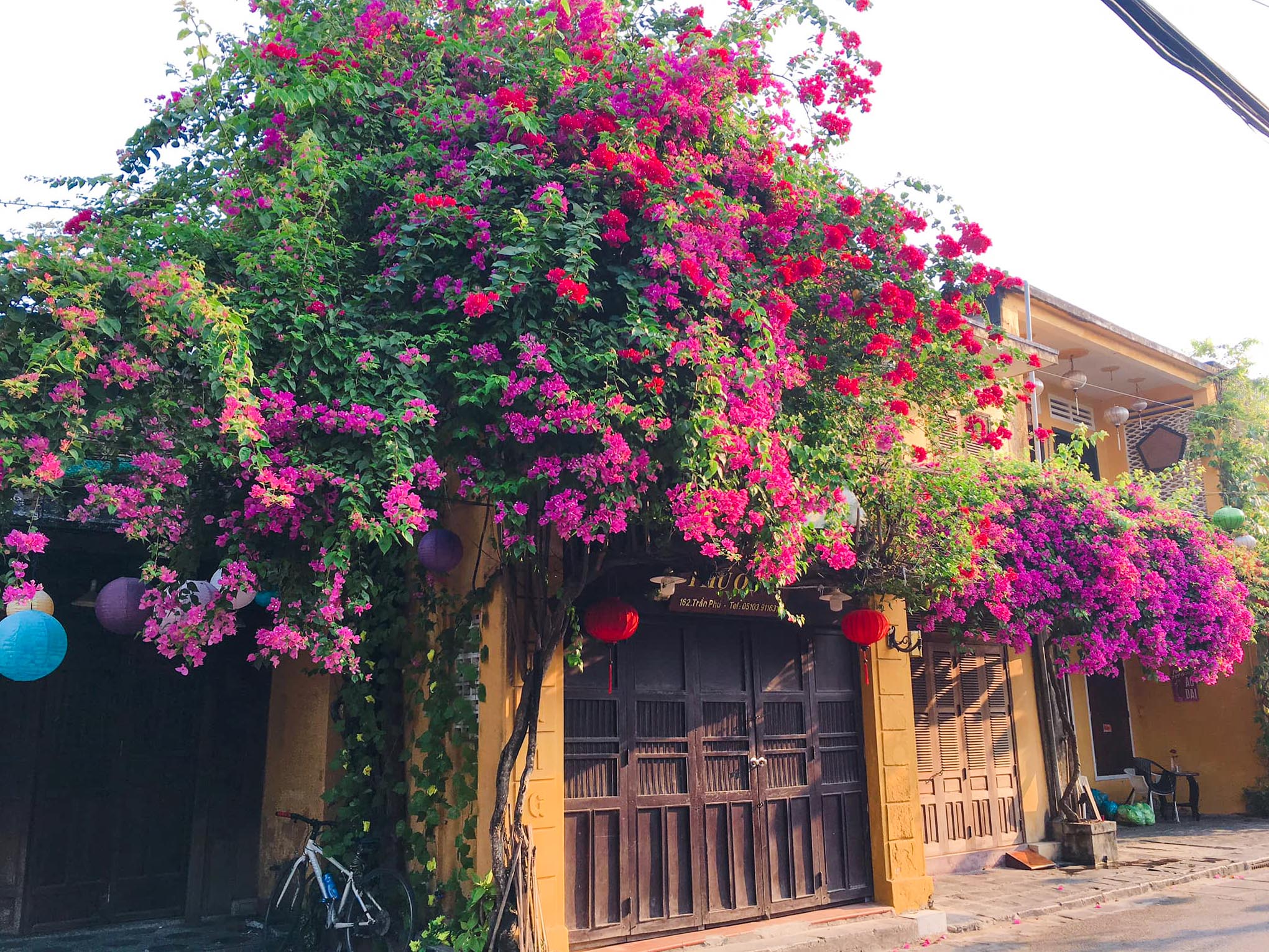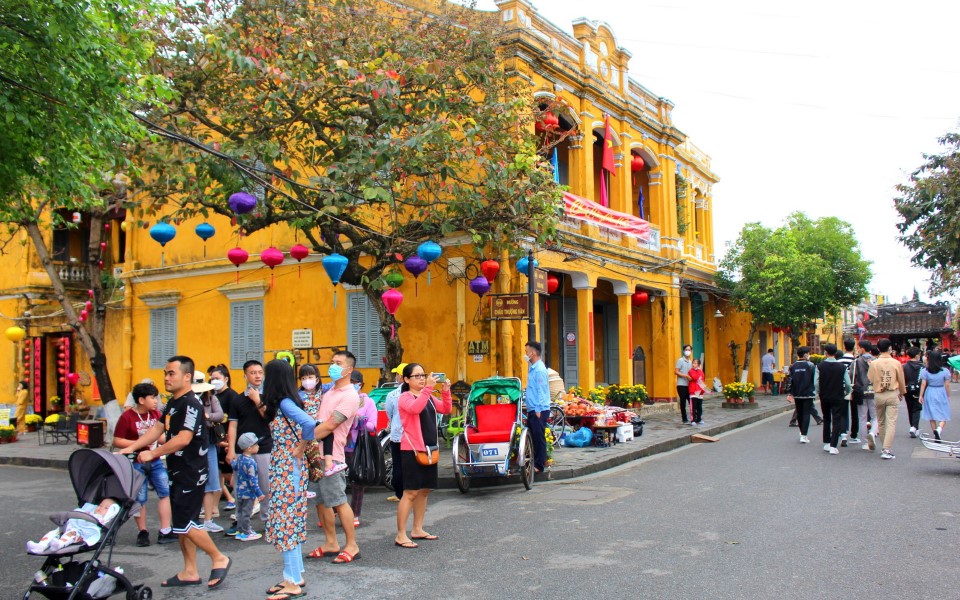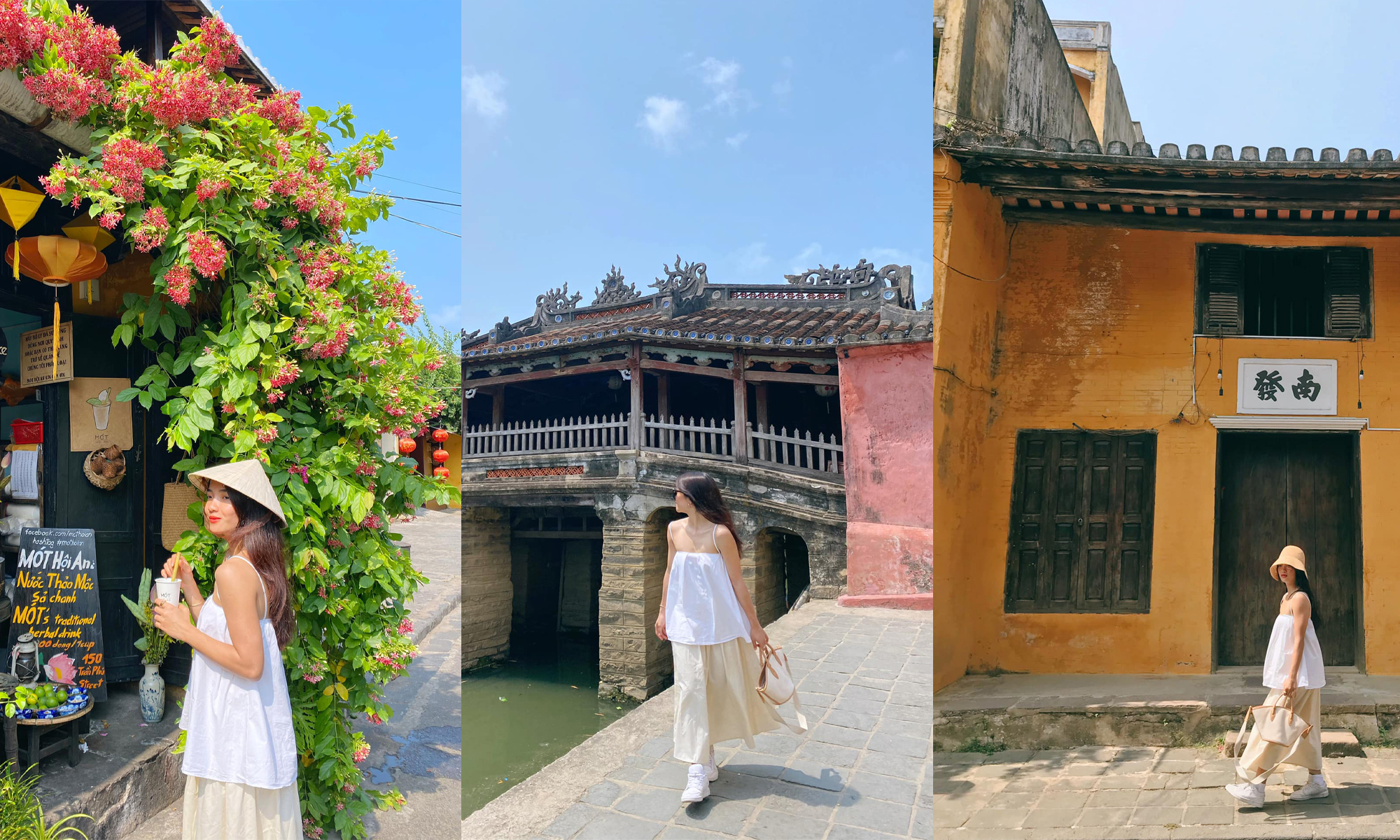Hoi An’s ancient town is not only famous for the Japanese Covered Bridge and hundred-year-old houses but also for its peaceful and poetic scenery, which can be seen through small cafes, narrow streets, paper flower-covered porches, and the sound of traditional boat racing on the Hoai River. It is worth visiting Hoi An at least once in your life.
After knowing what to eat in Hoi An, you surely need to know when to travel there, which month, and for how many days. This is to facilitate planning and scheduling your trip to Hoi An, as the weather in Hoi An can be quite uncomfortable, with scorching hot days and heavy rain on some days.
Table of Contents
What season and month should you travel to Hoi An? What are the temperature and weather like?
Hoi An is a city located in Quang Nam province, situated on the banks of the Thu Bon River, with two beautiful beaches, namely Cua Dai Beach and An Bang Beach, which are very famous. As a province located in the Central Coast, Hoi An is known to be influenced by a tropical monsoon climate. Therefore, this place has the characteristics of the climate of the central coastal regions, typically hot and humid with a lot of rain and sun.

Hoi An does not have a winter season as cold as the North or a hot season like the South, but the climate here, particularly in the Central region, can be considered quite harsh. Hoi An does not have the 4-season weather with Spring, Summer, Fall, and Winter, but is divided into two distinct seasons: rainy season and dry season, each lasting about half a year.
Regarding the temperature during the day, Hoi An has an average temperature range of 25.6 degrees Celsius per year, with the highest threshold being 39.8 degrees Celsius and the lowest threshold being 22.8 degrees Celsius. Hoi An also has a relative humidity, with an average humidity of 83% per year, 75% in the dry season, and 85% in the rainy season.
To help people better understand when to travel to Hoi An, we will discuss the characteristics of the dry and rainy seasons, including the pros and cons of each season, which will be analyzed more in the Hoi An Travel Guide below. For those who have never traveled to Hoi An, it is recommended to read carefully, as it will help a lot in terms of planning and scheduling time and budget.
If you are looking for a travel transportation company in Hoi An, Hoi An Private Car – Hoi An Car Rental With Driver is a company that has been providing transportation services for many years to domestic and international tourists, with a team of professional drivers who speak English, understand the roads in Hoi An,… they will help you have a timely and time-saving trip. Book now to get discounted prices.
What is the best season to travel to Hoi An? Is the rainy season or the dry season better?
The sunny season, also known as the dry season, is usually considered the ideal time to travel, not just in Hoi An but anywhere. Since Hoi An is adjacent to Da Nang, you can also refer to the best time to travel to Hoi An and Da Nang, which is very convenient.
For any trip, the weather and climate are important factors that greatly affect your trip. Therefore, if you want to go anywhere, you should first pay attention to the weather, and in Hoi An, there are two distinct seasons, the rainy season and the dry season. Although the dry season is always more favorable for transportation, sightseeing, and dining, the rainy season also has its own unique beauty.
Traveling to Hoi An in the dry season
How long does the dry season in Hoi An last?
The dry season usually starts from February and ends in August, or it could begin in January and finish in July, depending on the year.
What are the advantages of traveling to Hoi An in the dry season?
Based on the experience of independent travelers to Hoi An, this is the ideal time to explore the old town. With an average temperature of 33 degrees, it is very convenient for tourists to visit. There are some months with little to no rain and continuous sunshine from morning until evening. However, if you don’t like the intense heat of central Vietnam, you can choose to travel during the early or late dry season, when the weather is more pleasant.

To make it easier for everyone to understand, I will list some advantages of traveling to Hoi An during the dry season as follows:
- The hot and dry weather is very favorable for sightseeing and transportation.
- Ideal for diving to see coral reefs in Cu Lao Cham.
- There are diverse options for entertainment, food, and drink.
- The number of tourists visiting Hoi An is high, making it lively and bustling.
- There are many unique and attractive events and festivals after Tet Nguyen Dan (Lunar New Year).
- It is very convenient for taking Instagram-worthy photos and capturing beautiful memories.
Disadvantages when traveling to Hoi An in the dry season
However, there are some disadvantages to traveling to Hoi An during the dry season, although they do not greatly affect your trip:
- You may have to wait in line for a long time to buy tickets to visit the Old Town, Seven-Mau Coconut Forest, or to purchase canoe tickets to Cu Lao Cham.
- At some times during the dry season, the weather can be extremely hot, making it uncomfortable to be outside, especially from May to July.
- As the dry season is also the peak tourist season in Hoi An, it can be difficult to book nice accommodations, which can lead to overbooking and no availability for overnight stays.
- The high number of tourists in Hoi An during the dry season can lead to crowding and exhaustion, making it difficult to fully appreciate the peace and tranquility that Hoi An has to offer.
- The cost of services can be higher than usual, especially hotel rooms, which can increase by 20-50%, and food and drink may also be more expensive during peak season.
What to bring when traveling to Hoi An in the dry season?
- A phone and a portable charger to ensure uninterrupted photo taking.
- A jacket and sunscreen to protect against harmful sun rays.
- Swimwear if you plan to go to An Bang Beach or snorkeling in Cu Lao Cham.
- Your ID card if you plan to stay overnight in Hoi An or rent a motorbike.
- Sufficient budget for food and entertainment activities in the old town.
- It is recommended to book a hotel room at least one week in advance to avoid fully booked accommodations.
Traveling to Hoi An during the rainy season
The rainy season in Hoi An lasts from August to February of the following year. The rainy season in Hoi An is also known as the low season because the number of visitors is not as high as in the dry season. This is also an ideal time for those who want to experience the peaceful and ancient beauty of the old town. However, if you don’t know when to travel to Hoi An or check the weather forecast before you go, it’s easy to encounter rain, which can make it difficult for you to visit the town.

Advantages of traveling to Hoi An in the rainy season.
- Hoi An in the rainy season has a poetic and romantic beauty, suitable for those who want to explore the old town in a special way.
- The rainy season in Hoi An is always quiet and gentle, not as crowded as the dry season, so you will feel comfortable and relaxed when visiting.
- If you travel to Hoi An in the rainy season, you can save a considerable amount of money for your trip because at this time, services such as airfare and hotels are all reduced or offered with a variety of attractive promotions.
- Visiting Hoi An during this time, you will have the opportunity to admire the entire old town submerged in floodwaters. Hoi An at that time also has a very different and rare beauty that will surely be a memorable experience for you.
- After the heavy rainy days, winter comes to Hoi An. It rains less, and even though it’s cold, you can still visit Hoi An conveniently.
- The reality show called “Hoi An Memories” is still held on rainy days.
Disadvantages of traveling to Hoi An during the rainy season.
- Compared to the advantages, there are quite a few disadvantages when traveling to Hoi An during the rainy season:
- There are significant difficulties in moving and sightseeing, especially for those traveling to Hoi An by motorbike or bus.
- During this season, it rains heavily throughout the day, and after the rain, the streets become flooded, damp, and extremely uncomfortable.
- Certainly, if it rains, it will be difficult for you to capture sparkling photos with the sun’s rays or stroll on the streets to explore everything.
- Some street food and drink stalls will no longer appear, so you will miss out on the chance to taste specialties such as baked sweet potato, sweet soup, rice cake, skewered meat, etc.
- Outdoor activities such as Bai Choi, blindfolded pot smashing, or releasing sky lanterns will also be canceled due to the rain. If you miss out on these fun activities, what else is there to enjoy in Hoi An during the rainy season? There are countless inconveniences.
What to prepare when traveling to Hoi An during the rainy season?
If you still decide to visit Hoi An during the rainy season, in order to ensure the smoothest trip possible and ensure your health, you should prepare some of the following items:
- Raincoat, umbrella.
- Waterproof bag for your phone.
- Winter shoes, avoid wearing high heels that can cause you to slip.
- Warm clothes, scarves, gloves if the weather turns cold.
Book our private car from Danang to Hoi An now, and our driver will quickly pick you up at your hotel in Danang or any location of your choice. On the way, you can stop and visit famous landmarks…
What is the best time to travel to Hoi An for a beautiful sightseeing experience?
Traveling to Hoi An in January and February – ideal for strolling and sightseeing.
This is the time when Hoi An is still in the spring season before and after Tet, and the atmosphere of spring is still vividly present on every street and alley. This is also the time when Hoi An is transitioning from winter to spring, with pleasant and cool weather, occasional light rain showers, nothing to worry about.

Especially, summer festivals and holiday celebrations are lively and exciting, and visitors can not only admire the bustling Hoi An town but also participate in unique Tet festivals, learn more about the daily life and customs of Hoi An people.
Traveling to Hoi An in March and April – the weather is gradually transitioning to the dry season.
During these days, Hoi An is still in the transition period from spring to summer, the weather is still pleasant, not yet hot, and there are no more storms. As this is not yet peak season, service prices are lower compared to May-June-July.
Traveling to Hoi An in May, June, July – the best time to visit Hoi An.
From May to July is the end of the dry season in Hoi An, and the weather is perfect for sightseeing and other activities such as basket boat racing, beach bathing, and coral diving.

During the dry season, Hoi An remains dry throughout the day, but the most beautiful time is still at night when the weather is cool and ideal for exploring. It’s best to avoid visiting Hoi An at noon as it can be very hot, and start sightseeing from around 3-4 pm, combine it with evening entertainment for the best experience. If you only have one day to fully visit all attractions, you can book a 1-day tour to Cu Lao Cham Island and return to the Old Quarter to admire the ancient town.
Traveling to Hoi An in August, September – less rain, convenient for sightseeing.
This is the time when Hoi An is gradually entering the rainy season, with more rain starting in September, but in general, there is still a lot of sunshine. Note that this is still the peak season for Hoi An tourism, so service prices are reduced but still high, although cheaper than May-July. If you still don’t know which month and day to travel to Hoi An, you can choose this time for cheaper prices.
Traveling to Hoi An in October and November – It is a time when it is very likely to rain.
This is the rainy season in Hoi An, lasting about 2-3 months before entering the winter season. This is also the time when Hoi An is the least crowded and is considered the low season. It may not be suitable for tour groups or families with young children, but it can be a very interesting experience for young people to feel a different side of Hoi An. The feeling of walking on wet streets, admiring paper flower arrangements, and listening to the unique sounds on the ancient roofs is truly special.
Not only that, traveling at this time will help you save quite a bit of money because air tickets and hotels are heavily discounted, and other services are also cheaper. You will no longer see cheap services during the peak season, but instead receive more attentive and caring service.
The best time to travel to Hoi An that you should be aware of.
The question of when to travel to Hoi An is not too difficult, but it is not easy to answer. Ideally, the best time is from May to July due to the favorable weather. However, if you want to explore a more tranquil Hoi An with cheaper services and easier booking, then March, April, August, or September are also good options. Avoid going during the rainy season, from October to November, and if you only have time during this period, make sure to check the weather forecast beforehand.
How many days should you spend when traveling to Hoi An?
Based on calculations, spending 2 days and 1 night in Hoi An is enough. However, it also depends on your circumstances, whether you are traveling independently or with a tour, staying in a hotel or a resort. Nevertheless, it’s not recommended to stay too long. The best plan is to stop by Da Nang first, then spend about 2 days in Hoi An before heading back, as it would be a waste not to visit Da Nang while already in the area.
On the first day, you can visit the ancient town and tourist attractions inside, such as the Japanese Covered Bridge, Tan Ky Ancient House, and Phung Hung House. Mornings in Hoi An are quite quiet, while evenings are the best time to enjoy the town’s beauty, so you can use the mornings to visit places further away such as Tra Que Vegetable Village, Thanh Ha Pottery Village, and Bay Mau Coconut Forest. In the afternoon, return to the ancient town for more leisure activities.

If possible, spend the night in Hoi An so that you can head to Cu Lao Cham Island the next morning. This is an unspoiled island located in Tan Hiep Commune, Hoi An City. On the second day, we will begin the journey to visit Cu Lao Cham Island, which is best done by joining a tour. If departing from Hoi An, it will be cheaper than starting from Da Nang. If you have no experience buying canoe tickets or do not want to wait for hours for the boat, it’s best to join a tour where everything will be taken care of.
Now you know the best time to travel to Hoi An and how many days to spend there. All the information above has been carefully curated by the Hoi An Travel Guide team through many trips to Hoi An, and we hope you will find what you need there.



